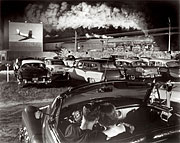O. Winston Link
“But, hark! there is the whistle of the locomotive – the long shriek, harsh, above all other harshness, for the space of a mile cannot mollify it into harmony.” Such is how Nathaniel Hawthorne considered the train in 1844, fifteen years after the first railroad began operation in this country. His remark anticipated similar sentiments that we find in the literature of the ensuing decades, including Thoreau’s meditation at Walden, as the train came to embody civilization’s industrial encroachment into nature.
This tension between industry and nature was still present as the age of the steam engine drew to a close in the middle of the last century. We can hear it in this audio recording by the photographer O. Winston Link, most likely made during the 1950s as the Brooklyn-born Link was documenting the steam engines on the Norfolk and Western Railway, which was the last main line to use them.
A heavy tonnage train makes its way up a steep hill at night. Crickets chirp from the grasses beside the rails, amidst a slowly crescendoing duet of the lead and pusher locomotives that results as they grind up the grade. Approaching Link’s position and the summit, the engineers pull their whistles, sending a triumphant cry into the night. Played here, beneath a rail bed that has been reclaimed by nature, the finale salute of the engines’ climb becomes much more than a symbol of the juxtaposition that Hawthorne found so violent. The engines’ climactic wail is both ecstatic and sorrowful, reverberating today as the melancholic echo of what Link called “the fading giant.”������������
����

Hotshot Eastbound, Iaeger, WV, 1950s��


